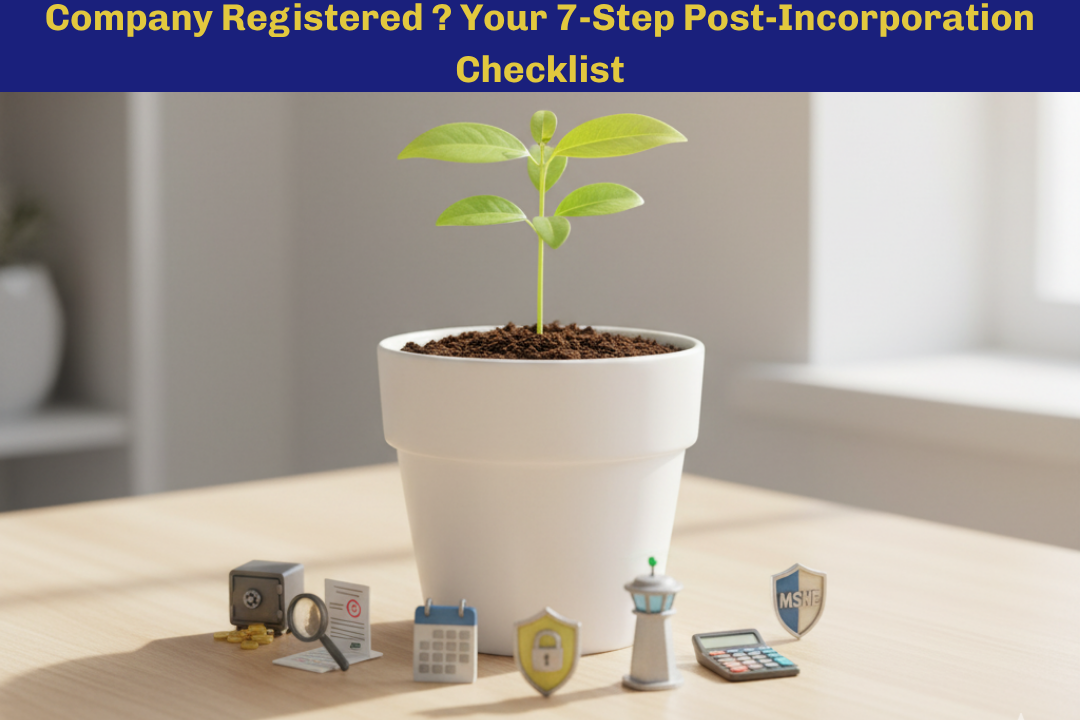Company Registered? Your 7-Step Post-Incorporation Checklist
By Filing Buddy . 25 Nov 25
Company Registered? Your 7-Step Checklist for the First 30 Days
Congratulations! The ‘Certificate of Incorporation’ from the MCA has landed in your inbox. You are officially the founder of a Private Limited Company. It’s a huge moment, the first big step in turning your idea into an empire.
But after the initial celebration, a new, slightly more nervous feeling usually sinks in: "Okay... what happens right now?"
If you're feeling a bit overwhelmed, you're not alone. Most founders discover there's a huge gap between their successful company incorporation and becoming a fully operational, compliant business.
Think of it this way: you just built a brand-new car. The company incorporation is the chassis and the engine. But you still can't legally drive it. You need insurance, a registration plate, and a driver's license. The first 30 days are all about getting your new "car" road-legal and ready to move.
That’s exactly why we built this 7-step checklist. This isn't more dry legal theory. This is your 30-day roadmap. We'll walk you through the exact critical legal, financial, and operational tasks you need to handle first. This guide will set your foundation, ensure you stay compliant from day one, and get you perfectly prepared for your first GST return and the rhythm of your annual compliance.

Let's get started.
Step 1: Hold Your First Board Meeting (Within 30 Days)
Okay, your company incorporation is done. Your first instinct is probably to start building your product or chasing clients. I get it. But pause. The law requires you to do one "boring" thing first, and you're on the clock.
You must hold your first Board of Directors meeting within 30 days.
"A board meeting?" you're probably thinking. "I'm a one-person company!" or "It's just me and my co-founder in a 2BHK. Do we really need to be this formal?"
Yes. But here's the reframe: Don't think of it as a stuffy, corporate-overlord meeting.
Think of it as the moment your company officially "wakes up."
Your Certificate of Incorporation is the company's "birth certificate." This first board meeting is its "first diary entry." It's the very first action your new legal entity takes, and you must write it down.
Why This Non-Negotiable Meeting is Your First Annual Compliance Task
The Registrar of Companies (ROC) needs proof that your company is a real, functioning entity and not just a "paper company" created to sit on a shelf. This meeting is your first piece of evidence.
This isn't just a pointless formality. This meeting is where you create the foundational legal documents that other, more important people (like your bank) will demand.
Skipping this is like building a house but forgetting to lay the cement for the foundation. Everything you build on top your bank accounts, your loans, your investments will be unstable. This meeting is the cement. It’s the very first, non-negotiable step in your long-term annual compliance marathon.
Your 3-Point Agenda: Appointing an auditor, authorizing a bank account, and allotting shares.
Your "meeting" might just be you and your co-founder at a Cafe Coffee Day. That's fine! What matters is that you formally discuss, agree on, and most importantly write down that you've passed resolutions on these three things:
1. Authorize the Bank Account: This is the most immediate, real-world part. You cannot walk into a bank and say, "Hi, I'd like to open a business account." They will laugh you out of the building. They will ask for a "Board Resolution." This document, which you create in this meeting, is the golden ticket. It's a formal, signed paper that says, "We, the directors, authorize this bank to open an account and this person (you) to sign the checks."
2. Appoint the First Auditor: "An auditor? Already? I haven't even filed my first GST return!" I know, it sounds premature. But the law says you must appoint a Chartered Accountant (CA) firm within 30 days.
Real-life analogy: It's like having to pre-book your car's first annual inspection the day you buy it. You're not getting inspected today, but you're legally required to have someone "on the books" to do it when the time comes. This resolution proves you've done that.
1. Allot Shares to Subscribers: This sounds like jargon, but it's simple. When you filed for company incorporation, you and your co-founders promised to buy a certain number of shares. This resolution is the company officially giving you those shares in exchange for that promised money (which you must now deposit into the new bank account). It's the final step in proving who owns what.
Real-Life Pitfall: Not holding this meeting (or not documenting it) can lead to penalties from the ROC right from the start.
Let's get specific. The "penalty" isn't just a small fine from the ROC. That's the least of your problems.
The Real-Life Pitfall is this:
Scenario 1: The Bank Rejection. You walk into the bank, all excited, to open your account. The bank manager asks for the Board Resolution. You don't have one. You can't open the account. You can't deposit client money. You can't pay for software. Your business is dead in the water.
Scenario 2: The Co-Founder Fight. A year from now, you and your co-founder have a major disagreement. They claim their shares were never officially allotted. You go to your company diary (the "Minute Book") to prove it... and the first page is blank. You just lost all your leverage, and you're heading for a legal nightmare.
Scenario 3: The Investor 'No'. You're pitching an angel investor. They ask to see your "corporate records" as part of their due diligence. You show them an empty folder. The investor sees you as an amateur who can't handle the basics and walks away.
The solution: Have the "meeting." Type up a one-page document titled "Minutes of the First Board Meeting." Use simple templates. State your three decisions. Have all directors sign it. Put it in a folder (digital and physical).
Done. You just laid your foundation and saved your future self a million-rupee headache.

You got it. Step 1 was about permission. Step 2 is about protection and identity.
Let's build that fortress.
Step 2: Secure Your Financial 'Fortress' (Bank Account & PAN/TAN)
You’ve held your first meeting. You’ve got a signed, official-looking document. Fantastic. Now, you need a place to put your money... and a way to tell the government who that money belongs to.
This step is all about building a firewall between you and your business.
Getting Your PAN and TAN (Your Business 'Identity')
First, your company needs its own identity cards. You'll almost always get these as part of your company incorporation process (in the SPICe+ form), but you must have them.
1. PAN (Permanent Account Number): If your Aadhaar is your unique ID, the company PAN is your business's unique ID. It’s the single most important number for all financial matters, from opening a bank account to filing income tax.
2. TAN (Tax Deduction and Collection Account Number): This is a different number. Think of it as your "I'm a responsible boss" license. You're legally required to have a TAN if you're going to pay salaries or make payments to contractors where you have to deduct TDS (Tax Deducted at Source).
You can't do business without these. They are the non-negotiable "entry pass" to the entire financial system.
Why a Separate Current Account is Your #1 Legal Shield
This is the most important piece of advice you will ever get. Do not, under any circumstances, use your personal savings account for your business.
I don't care if you're just a one-person startup. I don't care if your first client is your uncle.
Real-life Analogy: Think of your personal bank account as your home. Your new company is a... let's say, a large, excitable, slightly-on-fire-but-promising robot you just built.
Would you chain that robot to your dining table?
No! You'd build it a separate, fire-proof garage. A corporate current account is that garage. It's a "legal shield" known as the "corporate veil" that separates your business's finances (and its debts) from your personal finances (and your rent money).
The Real-Life Pitfall: If you mix them up paying for your groceries with the company debit card or taking a client payment into your personal account you've broken that shield.
Now, if your business gets sued or goes into debt, a lawyer can argue that there is no difference between you and your company. And suddenly, they're not just coming for your company's assets. They're coming for your personal car, your personal investments, and your personal bank balance.
A separate account is your firewall. It also makes your annual compliance and filing your GST return a thousand times easier. Your auditor will thank you (and charge you less).
Flow: "You'll need the board resolution from Step 1 to even open the account."
And here's the flow: Remember that "Board Resolution" you signed in Step 1? The one that authorized the opening of a bank account?
This is where you cash in that golden ticket.
You will physically walk into the bank of your choice, holding that signed Resolution, your PAN card, and your Certificate of Incorporation. The bank manager will see you're not an amateur. They'll see you've done the legal groundwork.
They'll see that you're ready for business.

Got it. You've got your bank account open and ready. Now, there's just one more "lock" on the door before you can actually start making money.
Let's pick that lock.
Step 3: File for 'Commencement of Business' (Form INC-20A)
You've got your Certificate of Incorporation (Step 0). You've held your first meeting (Step 1). You've opened your bank account (Step 2).
You'd think you're ready to start, right? Almost.
The government has one final "Are you sure you're serious about this?" checkpoint. It's a simple online form called INC-20A, or the 'Declaration for Commencement of Business'.
The Most Critical Step: What is Form INC-20A?
This form is a simple declaration you make to the Registrar of Companies (ROC). In it, you swear two things are true:
1. All the subscribers (the original founders) have paid the money for the shares they promised to buy during company incorporation.
2. The company has a verified registered office address (which you filed).
You must file this form. There is no "maybe." Without it, your company is a car with no keys.
Illustrative Example: Your 'Permission to Takeoff'
Here is the best way to think about it.
Your company incorporation was like building a brand-new airplane.
Your bank account (Step 2) was like filling the plane with fuel.
Form INC-20A is your 'Permission to Takeoff' from the control tower (the ROC).
You cannot legally pull back the throttle, leave the runway, or fly (i.e., commence business) until you get this one-time clearance. You can't take on debt, you can't sign major client contracts, you can't operate. This form proves you've put fuel in the tank (the shareholders paid) and you have a destination (a registered office).
The 180-day deadline (and why you must do it in the first 30).
The law gives you a very generous-sounding 180 days from your incorporation date to file Form INC-20A.
Do not wait 180 days. Waiting is the most common, and most foolish, rookie mistake.
Why? Because your business is paralyzed until you file it. You can't legally start earning revenue. What's the point of registering a company just to let it sit in a hangar for six months?
The Real-Life Pitfall:
Massive Penalties: Failing to file within 180 days brings heavy penalties. We're talking tens of thousands of rupees.
You Can't Borrow: Need a business loan? The bank won't even look at you until you've filed INC-20A.
The Ultimate Price: If you never file it, the ROC has the power to strike your company's name off the register. They can literally delete your company because you failed to prove it was real.
The takeaway: File this form the day your shareholder money hits the new bank account. Get it done in the first 30 days. It's the green light you've been waiting for. It turns your "paper" company into an operational one, ready to make sales and (eventually) file its first GST return.
Right, your company is now legally "live" thanks to Form INC-20A. You're ready to make money. But, as soon as money changes hands, the government wants to know about it.

Welcome to the world of GST.
Step 4: Register for GST (If & When You Need To)
This is the most common question I get from new founders: "Do I need a GST registration right now?"
The answer isn't a simple yes or no. It's a "yes, if..." or a "no, but..."
Let's cut through the confusion.
Who Needs a GST Registration? (Understanding the Threshold)
Think of the GST threshold as a "tax tripwire."
For most businesses, you're not legally required to get a GST registration until your total turnover (your total sales, not profit) crosses a certain line.
As of now, that line is generally ₹40 lakhs for businesses exclusively selling goods.
For those exclusively providing services, it's ₹20 lakhs.
(Note: These limits can be different for special category states. Always check the latest.)
"Great," you think, "I'm not going to hit ₹20 lakhs in my first month."
Hold on. That tripwire doesn't exist for everyone. You must register for GST from Day 1, regardless of turnover, if you:
1. Make any inter-state sales (sell services from Maharashtra to a client in Delhi).
2. Sell goods through an e-commerce platform (like Amazon or Flipkart).
3. Are a Non-Resident Indian (NRI) starting a business in India.
So, first, identify which boat you're in.
Why You Might Want to Register Even if You're Below the Threshold
This is the pro-tip. Let's say you're only selling services in your own state and you're well below the ₹20 lakh limit. Why would you voluntarily sign up for the paperwork?
Two massive reasons:
1. To Look Professional:
Real-Life Scenario: You're a new B2B (business-to-business) software company. You land a big client, like Tata or Infosys. You send them your first invoice. They look at it and ask, "Where is your GSTIN?" Sending an invoice without a GST registration number is like showing up to a board meeting in your pajamas. You can do it, but no one will take you seriously. Big companies expect you to be GST-compliant because their accounting depends on it
2. To Claim Input Tax Credit (ITC):
The "Cashback" Analogy: This is the most important part. Think of ITC as the government's "cashback program" for businesses.
When you buy a new laptop for your business, you pay GST on it. When you pay for your office internet, you pay GST.
If you are not registered, that GST is just a cost. You've lost it.
But if you are registered, the government "gives" you that GST back as "credits." You can then use these credits to pay the GST you collect from your clients.
Bottom line: Being registered means you don't lose money on the GST you pay for your business expenses. You get it back.
Getting your GSTIN is the first step to filing your monthly or quarterly GST return.
Once you register, you'll be given a unique 15-digit number: your GSTIN (Goods and Services Tax Identification Number).
This number is your golden key. You'll put it on your invoices, your website, and your office sign (as we'll see in the next step).
Most importantly, this GSTIN is the ID you will use to file your GST return every month or quarter. This return is where you tell the government, "Here's what I sold, here's what I bought, and here's the tax I owe (or the refund I'm claiming)."
This new, regular task will become a core part of your annual compliance rhythm. So, get it right from the start.

Here's the next section, following your flow and keeping the tone sharp and relatable.
Step 5: Set Up Your 'Official' Registered Office
Your company is now a legal entity (Step 3) and tax-aware (Step 4). Now, let's talk about its "home."
The address you listed in your company incorporation forms isn't just a mailbox. It's your official "Registered Office," and the law has some very specific, non-negotiable rules about what you must do with it.
This is one of the most easily overlooked steps, and it's a dead simple way to get into trouble.
The Legal Requirement: Displaying Your Name, CIN, and GSTIN
The Companies Act and GST laws are very clear on this: you must be transparent. You can't be an anonymous "paper company."
This transparency is required in two main places:
1. At Your Physical Office: You are legally required to have a "signboard" outside your registered office. Yes, a physical sign. Even if your registered office is your apartment. It must clearly and legibly display:
1. Your Company's Full Name (as on the Certificate of Incorporation)
2. Your 21-digit CIN (Corporate Identity Number)
3. Your Registered Office Address (which should be... right there)
4. Your 15-digit GSTIN (if you are registered)
2. On All Your "Paperwork": This is the one people really miss. The same level of transparency is required on all your official business communications. You must have your company name, CIN, registered office address, phone/email, and GSTIN printed on:
1. All business letters
2. All invoices and billheads
3. All official notices
4. Your official website
Real-Life Example: "Yes, you must have a sign. And your GSTIN must be on your letterhead and website. This is a simple but easily-missed part of compliance."
This sounds like a tiny, "who cares?" detail, right? Wrong.
Real-Life Pitfall:
Scenario 1: The Inspector Visits. A GST officer or an inspector from the Registrar of Companies (ROC) decides to do a spot check. They show up at your registered address and... there's no sign. It's just a residential building with no mention of your company. RED FLAG. This is the fastest way to trigger an inquiry or a penalty for non-compliance. It makes you look like a shell company.
Scenario 2: The Client Rejects Your Invoice. You send your first big invoice to a professional client. But it's just a simple Word doc. Their finance department rejects it and sends it back, "This is not a valid tax invoice. Please add your company's CIN and GSTIN." It not only delays your payment, but it screams "amateur."
The takeaway: Think of this as your company's "number plate." You wouldn't drive a car without one, right? This proves your business is legitimate and accountable.
This is a 30-day task. You don't need a giant, expensive neon sign. Just get a simple, professional nameplate. Go into your invoice template and add a footer with all these details. Update your email signature. It's the easiest 10-point check on your annual compliance list. Get it done.
You got it. We've officially cleared the "mandatory survival" steps. Now we move into the "smart founder" steps.

Steps 1-5 were about keeping you compliant and out of trouble. This step is about building real, long-term value.
Step 6: Protect Your Intellectual Property (Brand & Business)
So far, all our tasks have been about compliance. Now, let's talk about assets.
Your business isn't just a CIN and a GSTIN. It's an idea. A brand. A reputation. And that reputation is an asset you must protect just as fiercely as the money in your new bank account.
This step isn't about avoiding penalties; it's about creating value.
The "Day 1" Advantage: Filing a Trademark for Your New Brand
This is the single most important "pro-tip" on this entire list. And it's based on a
misconception almost every new founder has:
"But I already registered my company name with the MCA! Isn't that the same thing?"
No. No, it is not. And this mistake can cost you your entire business.
Your MCA Name (Company Incorporation): This is just your legal name. It's like your birth certificate. It stops someone else in your state from registering a company with the exact same legal name. That's it.
A Trademark: This is your brand name. This is your logo. This is your "Go-To-Market" identity. A trademark gives you nationwide protection, preventing anyone in your business category from using a name that sounds even similar to yours.
The Real-Life Pitfall: The "Rebrand of Death"
Scenario: You build your brand "QuickBox" for two years. You're getting clients, you're growing.
One day, you get a legal notice. A company in Delhi that you've never heard of filed a trademark for "KwikBoks" a year after you started, but before you thought about it.
The Result: They own the name. You don't. You have to change everything: your website, your logo, your packaging, your social media handles... everything. You've lost all your brand equity.
Filing a trademark on Day 1 is like planting your flag on the moon. You're claiming that territory, and the "Day 1" part gives you legal priority over anyone who comes after.
Get Your 'Udyam' (MSME) Registration for government benefits.
If a trademark is your shield, the Udyam Registration is your booster pack.
This is a free, simple, online registration that officially classifies your new company as a Micro, Small, or Medium Enterprise (MSME).
Analogy: Think of this as the "Student ID" for your new business.
Just by having this ID, you unlock a whole menu of government benefits, including:
Easier Bank Loans: Banks have specific quotas and lower interest rates for MSME-registered businesses.
Payment Protection: Is a big corporate client delaying your payment? The MSME Samadhaan portal gives you special legal powers to get your money, with interest.
Government Tenders: Many government contracts are reserved only for MSMEs.
Subsidies: You can get rebates on things like patent or trademark filing fees.
It's free, it takes 15 minutes, and it opens doors. Not doing it is like leaving free money on the table.
This isn't mandatory, but it's what smart founders do to build long-term value.
This is the key takeaway. Your annual compliance will force you to file your taxes. But nothing will force you to build a valuable brand.
An investor doesn't just buy your revenue; they buy your brand. A trademark and an Udyam registration aren't just certificates for the wall. They are entries on your company's balance sheet. They are real, tangible assets.

Here is the final step, designed to tie everything together and pivot the reader from "setup" to "action."
Step 7: Set Up Your Compliance & Operations 'Rhythm'
You’ve made it. You've survived the 30-day "setup sprint." You’ve built your foundation, put up your shields, and gotten your legal-eagle ducks in a row.
Now, welcome to the marathon.
The final step is to understand that compliance isn't a one-time task you can "finish." It's a "rhythm" , a calendar of recurring tasks that keep your company healthy and in good standing with the government.
Your Annual Compliance is Not a 'One-Time' Thing
Your company incorporation was a single event. Your annual compliance is a system.
Analogy: You just bought a gym membership (that's your incorporation). But to stay "healthy," you have to actually go to the gym every week (that's your compliance).
This is your new business-as-usual:
Monthly/Quarterly: Filing your GST return.
Annually: Holding your Annual General Meeting (AGM) and filing your big annual compliance forms with the ROC (like AOC-4 for finances and MGT-7 for your annual report).
The goal isn't to be afraid of these dates, but to prepare for them. And that brings us to the single most important tool in your arsenal...
Choose Your Accounting Software (This makes GST returns painless)
Please, I am begging you: do not try to run your company on an Excel spreadsheet.
The Real-Life Pitfall: You use Excel. You're busy. You forget to log a few invoices. Come March, it's tax time. You're digging through emails, trying to find a receipt from eight months ago. You have no idea what your real profit is. Filing your GST return is a 3-day nightmare of panic-math.
A good accounting software (like Zoho, Tally, or QuickBooks) is not a "nice to have." It is a "non-negotiable."
It's your financial dashboard. It's your single source of truth. It makes filing your GST return a 10-minute "click-to-file" job instead of a tear-filled weekend-ruining disaster. This software is the difference between being a professional business owner and playing "catch-up" forever.
"Managing annual compliance and GST returns is a full-time job."
Let's be blunt: all of this sounds like a lot, doesn't it?
Holding meetings, filing forms, tracking GST, managing accounting software... this is all distracting. It's a full-time job. And it's the #1 thing that distracts founders from their full-time job: growing their business, serving their clients, and building their empire.
That's where we come in.
"Learn how we handle your entire compliance calendar
3. GST returns
5. ITR Return
Now, You're Ready: Go Make Your First Sale.
And... that's it. You've done it.
You've gone from an "idea" in your head to a fully legal, compliant, and operational company. You've built the car, gotten it registered, insured it, and filled the tank.
The foundation is set. The "boring" (but critical) part is over.
Now, go. Pick up the phone. Call that first client. Launch that website.
Go make your first sale.

Conclusion: Your First 30 Days, Done.
Let’s take a breath.
We’ve covered a lot of ground, moving from that first exciting "Certificate of Incorporation" to building a fully compliant, operational business in 30 days. You’ve gone from a simple company incorporation to a smart founder who has a bank account, a GSTIN, a protected brand, and a clear path forward.
This list might look long, and if you're staring at it feeling a little overwhelmed, that's completely normal.
Here’s the secret: You don't have to do all 7 steps today.
This isn't a single-day sprint; it's a step-by-step path. Your only job today is Step 1. Tomorrow, focus on the next. Focus on one at a time. You’ve already done the hardest part: starting. You’ve got this.
Now, we want to hear from you. We know this journey sparks a ton of questions.
What's the #1 question you have about your annual compliance or GST setup?
Ask Us By Connecting with us.
Contact us
FAQs
1. What is the very first thing I must do after company incorporation?
The first mandatory task is to hold your first Board Meeting within 30 days of incorporation. This is a legal requirement to appoint your first auditor, authorize the opening of a corporate bank account, and allot shares to the subscribers.
2. Can I just use my personal bank account for my new company?
No, you absolutely must not. Using a personal account "commingles" your funds and breaks the "corporate veil." This means if your company is sued or has debt, your personal assets (like your home or car) could be at risk. A separate corporate bank account is your #1 legal shield.
3. What is Form INC-20A and when do I file it?
Form INC-20A is a mandatory "Commencement of Business" declaration. You must file it with the ROC within 180 days of incorporation, but after your shareholders' capital is deposited in the company's bank account. You cannot legally start any business operations or take on debt until this form is filed.
4. When do I need to register for GST for my new company?
You are legally required to get a GST registration if your annual turnover exceeds ₹20 lakhs for services or ₹40 lakhs for goods. However, you must register immediately (regardless of turnover) if you sell to other states, sell on e-commerce platforms (like Amazon), or are an NRI-owned business.
5. Is my registered company name (from the MCA) the same as a trademark?
No, and this is critical. Your company name registration only stops others from registering the exact same legal name. A trademark protects your brand name, logo, or slogan nationwide and prevents others in your industry from using a name that is even similar. You must file for a trademark separately to protect your brand.
6. What is the difference between a company PAN and a TAN?
A PAN (Permanent Account Number) is your company's main tax ID, like an Aadhaar for the business. It's needed for opening a bank account and filing income tax. A TAN (Tax Deduction and Collection Account Number) is only required if you are responsible for deducting tax at source (TDS), such as when paying salaries or contractors.
7. Do I really need to put a signboard outside my registered office?
Yes, it's a legal requirement. The Companies Act mandates that you must display a signboard outside your registered office with the company's full legal name, its CIN (Corporate Identity Number), and its registered office address. If you have a GSTIN, that must be displayed as well.
8. What is "annual compliance" for a Private Limited Company?
Annual compliance is the set of mandatory yearly filings your company must submit to the Registrar of Companies (ROC) and tax authorities. The main requirements include holding an Annual General Meeting (AGM), filing your financial statements (Form AOC-4), and filing your annual report (Form MGT-7).
9. What happens if I miss my annual compliance deadlines?
Missing your deadlines results in heavy, automatic penalties from the ROC that are calculated on a per-day basis. It is not a one-time fine. Continuous non-compliance can lead to the directors being disqualified and the company being "struck off" (deleted) from the official register.
10. Why should I get a GST registration if I'm below the ₹20 lakh limit?
Two main reasons:
1) Professionalism: Large corporate clients will expect you to have a GSTIN to treat you as a serious, legitimate vendor.
2) Input Tax Credit (ITC): If you are registered, you can claim back the GST you pay on your own business expenses (like laptops, software, or office rent), which lowers your costs.
Contact Us
An expert will call you within 24 hours. No payment required to get started.
Related Post

How to Obtain a Company Registration Number in India
Understanding Corporate Identification Numbers (CINs) and How to Obtain Them in India
. 2 mins.png)
Difference between Udyog Adhaar and Udyam Certificate
Want to get registered for Udyog Aadhar and Udyam Certificate? Here is their registration processes. Also, know about their differences. Explore their features, benefits, and processes to register online for each, helping you to choose the right option as per your need.
. 3 min read.png)
Changing Your Bank Signatory? Here are the Y Documents Required by Most Banks in India
Learn how bank signatory is important for financial workflow. Know why bank signatories are important and discover the documents required to change signature of your signatory.
. 5 min read

